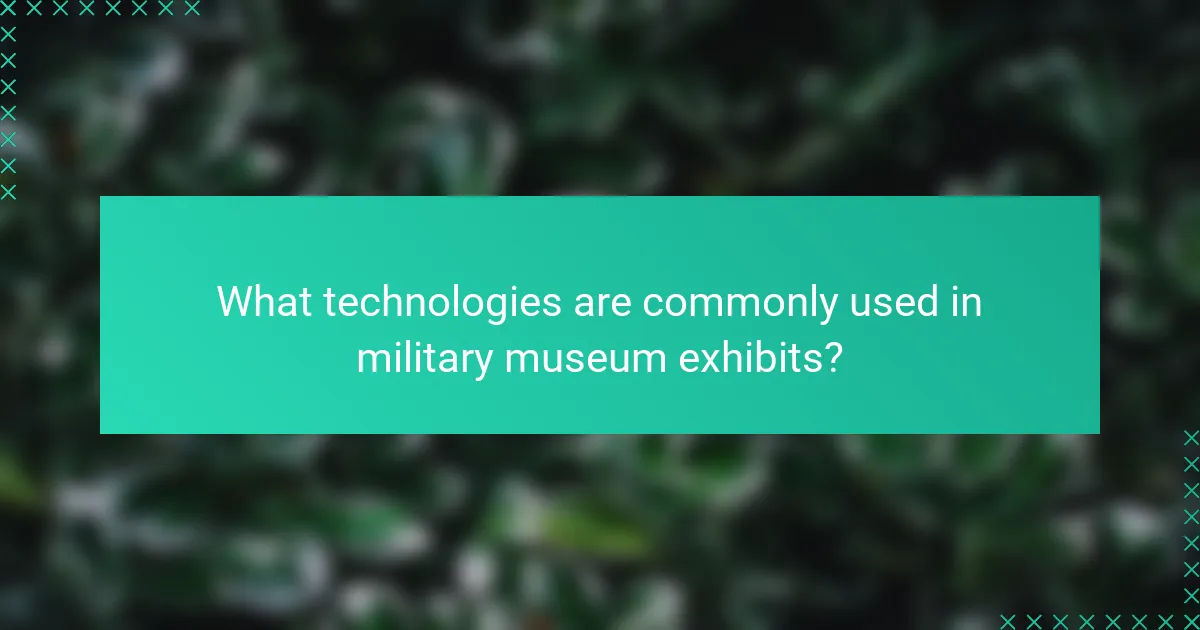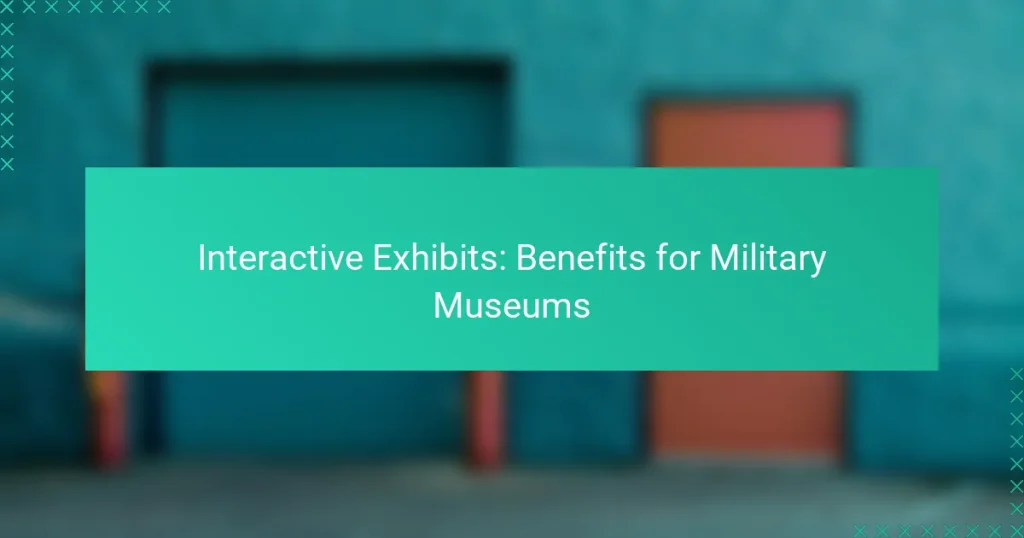Interactive exhibits play a crucial role in enhancing military museums by providing immersive experiences that engage visitors and enrich their understanding of military history. By incorporating advanced technologies such as augmented reality and virtual reality, these exhibits create dynamic and memorable learning environments that make history more accessible and relatable to a diverse audience.

How do interactive exhibits enhance military museums in the United States?
Interactive exhibits significantly enhance military museums by creating immersive experiences that engage visitors and deepen their understanding of military history. These exhibits utilize technology and hands-on activities to make learning more dynamic and memorable.
Engagement through technology
Interactive exhibits leverage technology such as virtual reality, augmented reality, and touchscreen displays to captivate visitors. For example, a virtual battlefield simulation can allow users to experience historical events firsthand, making the learning process more engaging. This use of technology not only attracts a wider audience but also encourages repeat visits.
Additionally, gamification elements, like quizzes or challenges, can motivate visitors to explore exhibits more thoroughly. By incorporating these interactive features, museums can transform passive observation into active participation, enhancing visitor satisfaction.
Educational value for visitors
Interactive exhibits provide educational benefits by presenting complex military concepts in an accessible manner. Through simulations and hands-on activities, visitors can grasp the significance of military strategies, technologies, and historical events more effectively than through traditional displays. This experiential learning fosters a deeper understanding of the subject matter.
Furthermore, interactive elements can cater to various learning styles, making it easier for individuals to absorb information. For instance, visual learners may benefit from interactive maps, while kinesthetic learners engage better with physical artifacts they can manipulate.
Preservation of military history
Interactive exhibits play a crucial role in preserving military history by making it relevant to contemporary audiences. By connecting past events with modern technology, museums can highlight the ongoing significance of military history in today’s society. This relevance encourages visitors to appreciate and respect the sacrifices made by service members.
Moreover, these exhibits can help document and showcase personal stories and artifacts that might otherwise be overlooked. By allowing visitors to interact with these narratives, museums can ensure that the legacy of military service is honored and remembered for future generations.

What are the key benefits of interactive exhibits for military museums?
Interactive exhibits significantly enhance the visitor experience in military museums by promoting engagement and deeper understanding of military history. These exhibits foster a more immersive learning environment, making history accessible and relatable to a wider audience.
Increased visitor retention
Interactive exhibits can lead to higher visitor retention rates as they encourage guests to spend more time exploring. By incorporating hands-on activities, simulations, and multimedia presentations, museums can create memorable experiences that visitors are likely to share with others.
For example, a military museum that features a virtual reality combat simulation may attract visitors who want to experience a soldier’s perspective. This type of engagement can result in longer visits and increased likelihood of return trips.
Enhanced learning experiences
Interactive exhibits enhance learning by allowing visitors to engage with the material in a dynamic way. Instead of passively observing artifacts, guests can participate in activities that reinforce their understanding of military strategies, technologies, and historical events.
For instance, a museum might offer interactive displays where visitors can manipulate models of military equipment or participate in decision-making scenarios based on historical battles. This hands-on approach caters to various learning styles and can improve knowledge retention.
Attraction of diverse audiences
By implementing interactive exhibits, military museums can attract a broader range of audiences, including families, school groups, and technology enthusiasts. These exhibits appeal to younger generations who prefer engaging and participatory experiences over traditional displays.
To maximize this potential, museums should consider incorporating elements that resonate with different demographics, such as gamified learning experiences for children or in-depth technological showcases for adults. This strategy not only increases foot traffic but also fosters a more inclusive environment for learning about military history.

What technologies are commonly used in military museum exhibits?
Military museums often utilize advanced technologies to enhance visitor engagement and education. Key technologies include augmented reality, virtual reality, and interactive touch screens, each offering unique experiences that bring history to life.
Augmented reality applications
Augmented reality (AR) applications overlay digital information onto the real world, allowing visitors to interact with historical artifacts in innovative ways. For example, using a smartphone or tablet, visitors can view 3D models of military equipment or soldiers in action, enhancing their understanding of historical contexts.
When implementing AR, consider the user experience and ensure that the technology is intuitive. Providing clear instructions and maintaining a balance between digital and physical elements can significantly improve engagement.
Virtual reality simulations
Virtual reality (VR) simulations immerse users in a fully interactive environment, replicating historical battles or military training scenarios. Visitors can experience what it was like to be in a specific time and place, which can be both educational and emotionally impactful.
To create effective VR experiences, focus on high-quality graphics and sound design. Ensure that the simulations are accessible to a wide audience, including those who may not be familiar with VR technology. Offering guided sessions can help newcomers navigate the experience.
Interactive touch screens
Interactive touch screens provide a hands-on way for visitors to explore military history. These screens can display maps, timelines, and detailed information about exhibits, allowing users to delve deeper into topics of interest at their own pace.
When designing interactive touch screens, prioritize user-friendly interfaces and engaging content. Incorporating multimedia elements like videos and audio clips can enhance the learning experience. Regularly updating the content keeps the exhibits fresh and relevant for returning visitors.

How can military museums implement interactive exhibits effectively?
Military museums can implement interactive exhibits effectively by integrating technology that enhances visitor engagement and learning. This involves strategic planning, collaboration with technology experts, and continuous evaluation of visitor experiences.
Collaboration with tech companies
Partnering with technology companies can provide military museums access to cutting-edge tools and expertise. These collaborations can lead to the development of immersive experiences, such as virtual reality simulations or interactive displays that bring historical events to life.
When selecting tech partners, consider their experience with educational projects and their ability to tailor solutions to the museum’s specific needs. Establish clear goals and expectations to ensure that the technology aligns with the museum’s mission.
Training staff for technology use
Training staff is crucial for the successful implementation of interactive exhibits. Staff should be well-versed in operating new technologies and able to assist visitors in navigating these experiences. Regular training sessions can help staff stay updated on the latest tools and techniques.
Consider developing a training program that includes hands-on workshops and ongoing support. This will empower staff to troubleshoot issues and enhance visitor interactions, creating a more enriching experience for all.
Gathering visitor feedback
Collecting visitor feedback is essential for refining interactive exhibits. Museums can use surveys, comment cards, or digital feedback tools to gather insights on visitor experiences and preferences. This information can guide future improvements and help tailor exhibits to better meet audience expectations.
Implement a systematic approach to analyze feedback, identifying common themes and areas for enhancement. Regularly reviewing this data will enable museums to adapt and evolve their interactive offerings, ensuring they remain relevant and engaging.

What are the costs associated with developing interactive exhibits?
Developing interactive exhibits involves various costs, including initial investments in technology and ongoing maintenance expenses. Understanding these costs is crucial for military museums aiming to enhance visitor engagement through interactive experiences.
Initial investment for technology
The initial investment for technology can vary significantly based on the complexity and type of interactive exhibit. Costs may range from a few thousand to several hundred thousand USD, depending on factors like hardware, software, and design. For instance, a simple touchscreen kiosk might cost around $5,000, while a fully immersive virtual reality setup could exceed $100,000.
When planning, consider not only the purchase price but also installation and training costs. Engaging a specialized vendor can ensure that the technology aligns with the museum’s goals and audience needs.
Ongoing maintenance expenses
Ongoing maintenance expenses are essential to keep interactive exhibits functioning smoothly. These costs typically include software updates, hardware repairs, and content refreshes, which can amount to 10-20% of the initial investment annually. Regular maintenance helps prevent downtime and ensures that exhibits remain engaging for visitors.
It’s advisable to budget for these expenses during the planning phase. Establishing a maintenance schedule and training staff to handle minor issues can help mitigate costs and prolong the lifespan of the technology.
Funding opportunities and grants
Funding opportunities and grants can significantly offset the costs associated with developing interactive exhibits. Many military museums can access federal, state, and private grants specifically aimed at enhancing educational experiences. Organizations like the National Endowment for the Humanities or local arts councils often provide funding for innovative projects.
To maximize funding potential, museums should prepare comprehensive proposals that outline the educational benefits and community impact of their interactive exhibits. Collaborating with educational institutions or other museums can also strengthen grant applications and provide additional resources.


